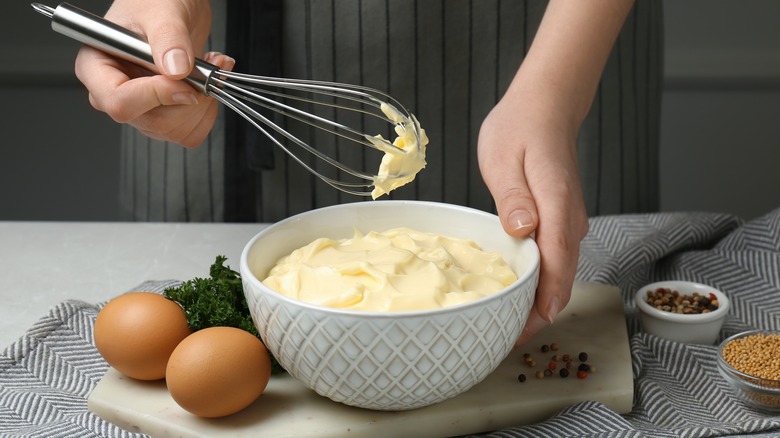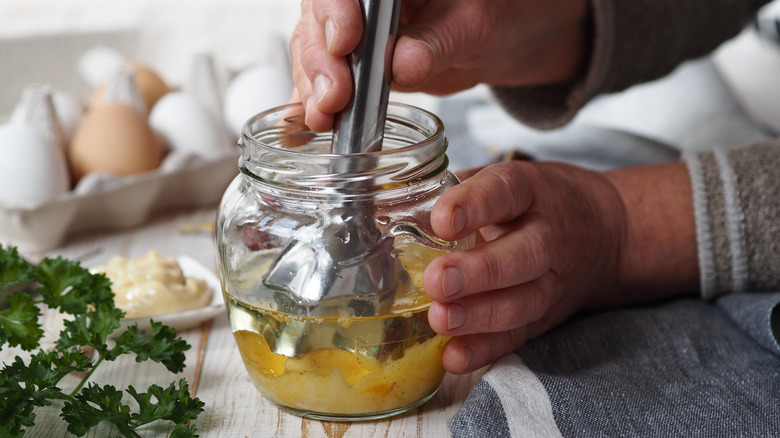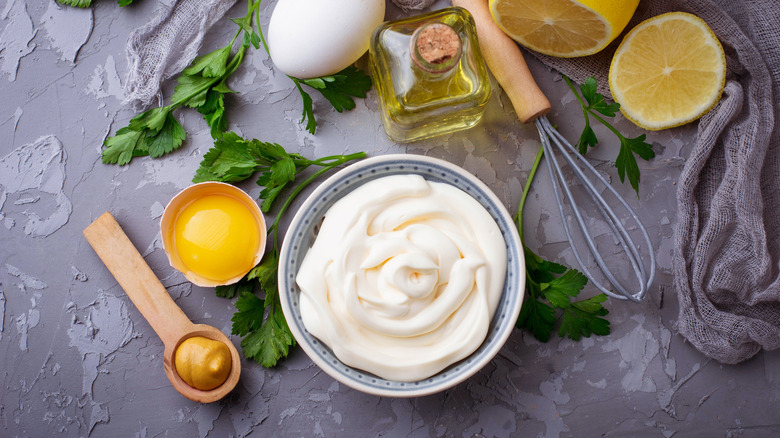How To Save Your Broken Homemade Mayonnaise
Making mayonnaise at home may seem deceptively simple. After all, what else do you need except a few eggs, a bit of oil, and a dash of lime juice or vinegar to create the thick and creamy condiment? However, if you closely examine these three ingredients, you'll understand why making mayo at home can often be a complicated affair. Mayo is crafted from ingredients that don't naturally blend together. It's an emulsion, created by combining oil with the water from egg yolks and vinegar, using the help of an emulsifier — in this case, the lecithin present in the yolks.
However, mastering an emulsion is easier said than done, and there's a lot that could disrupt this delicate blend of liquids, causing the velvety sauce to separate into a curdled mess with pools of oil floating on the top. But it's a problem that can be fixed. All you have to do is re-emulsify the broken mayo. You can achieve this by taking an extra egg yolk in a separate bowl and whisking in the broken mayo little by little until it thickens and regains its homogeneous appearance. Essentially, you're starting the emulsion by gradually adding the oily broken mayo to a watery bowl of egg yolk. Therefore, be sure to add mayo to the yolk very slowly and in very small batches.
More ways to fix a broken mayo
While cracking an extra egg yolk is one way to salvage your broken mayonnaise, there are other remedies to fix the sauce as well. Much like the egg method, you can add spoonfuls of separated mayo into a bowl containing a teaspoon of mustard sauce. Whisk the mixture slowly until it begins to emulsify, and then incorporate the remaining separated mayo into the bowl. This approach works because mustard also serves as an excellent emulsifier that can help bind your mayo together. You can even combine the egg and mustard methods by whisking the broken mayo into a bowl containing both an extra egg yolk and a dash of mustard.
Sometimes, the solution can be as simple as adding a teaspoon or two of boiling water directly into the broken mayo to aid in its emulsification. Other times, understanding why your mayo is broken or what it looks like can be the key to rescuing it. For instance, if excess oil appears to be the cause of the problem, gradually beating the separated mayo in a bowl of lemon juice or vinegar will remedy the situation. However, if your mayo is too thin and runny or refuses to emulsify due to the ingredients being too cold, a room-temperature egg yolk is what you need.
Preventing your mayo from splitting in the first place
Making mayo at home requires a careful approach, and avoiding certain pitfalls will go a long way in ensuring that you don't have a split to fix in the first place. Several factors can compromise the emulsion of your mayo and lead to it breaking: your ingredients may not have been at room temperature, or the eggs might not have been very fresh, both of which can cause the sauce to separate.
The proportion of oil and water — or in other words, egg yolks and acid — matters too, as does the pace at which they are mixed together. Pouring all of the oil in too quickly is a sure way to end up with broken mayo. Instead, a better method to emulsify the sauce is to drizzle spoonfuls of oil into the yolks and acid while blending slowly. Continue adding the oil in small quantities until the sauce stabilizes enough for you to pour in the rest. The type of oil used can also be a contributing factor. For example, the monoglycerides present in unrefined oils can cause mayo to split, whereas neutral-tasting vegetable oils do a much better job of keeping everything together. Nevertheless, you'll find that emulsions like mayo are volatile and prone to breaking, so regardless of the precautions you take, it's always good to know that there is a way to fix the mayo even if it all seems to go south!



